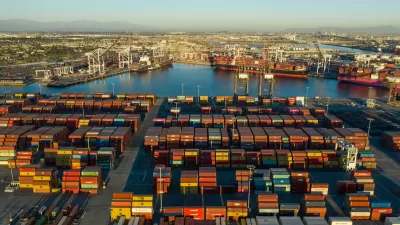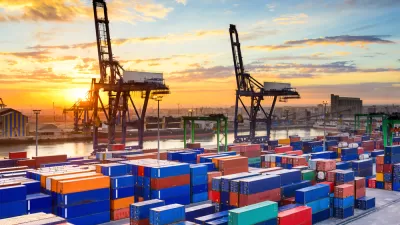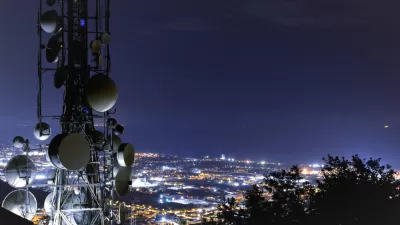This morning I was reading through my daily dose of planning related blogs and dropped in on The Overhead Wire, Jeff Wood's excellent transit soapbox. One of Jeff's most recent posts links to an October 25th Reuters article announcing China's $272 billion dollar investment in new rail infrastructure. Yes, you read that correctly. 272 billion. Can't you see president Hu Jintao bringing his pinky to his lips, à la Dr. Evil?
This morning I was reading through my daily dose of planning related blogs and dropped in on The Overhead Wire, Jeff Wood's excellent transit soapbox. One of Jeff's most recent posts links to an October 25th Reuters article announcing China's $272 billion dollar investment in new rail infrastructure. Yes, you read that correctly. 272 billion. Can't you see president Hu Jintao bringing his pinky to his lips, à la Dr. Evil?
Meanwhile, our main stream media, and by extension much of America, seem distracted by political non-issues like Sarah Palin's wardrobe to give sufficient coverage to this incredible piece of news.
Should this not be a serious kick in the pants ?! A call to arms? I can see it now, millions of new t-shirts minted at Urban Outfitters that say "Rails not Wars" printed over a fashionably faded American flag. Faux hipsters will buy them by the millions with proceeds going to, well, rails and not wars. I digress.
Reconnecting America often refers to American cities' relatively recent rush to fund transit projects of all kinds with an inadequate pool of federal support money as the Transit Space Race.
Jeff's aforementioned blog post places the race in a more global context:
I don't know about you all, but I can't even imagine a scenario where
we pump that much money into freight and passenger rail lines because
our politics would get in the way. That is almost double the demand
that exists in the United States for new transit lines and certainly an
investment like that in the United States would be an enormous benefit
for our future ancestors. Are we going to see the light? Or fall
further behind?
China is clearly investing intelligently in their own 21st century, one where building something tangible and long-lasting like rail will produce more sustainable econonic growth for rural and urban areas alike.
America on the other hand is clinging to economic bailout straws. According to many experts such a measure does not
guarantee a lasting economic recovery, nor will it produce something as basic
and beneficial as a modern passenger and freight rail network that should contribute to the
transit rich towns and cites we will need as the 21st century
progresses. Meanwhile, a nationwide infrastructure crisis continues to deepen and an economic recession grows.
Jim Kunstler often says, we have become a very unserious nation, one that is far too used to getting something for nothing. I don't think there is a better way to describe the psychological roots of the Wall-Street mortgage meltdown.
We have fallen asleep at the wheel and China's recent investment should serve as our wake-up call.
After all, we can't win a race if we choose not to compete in the first place.

Manufactured Crisis: Losing the Nation’s Largest Source of Unsubsidized Affordable Housing
Manufactured housing communities have long been an affordable housing option for millions of people living in the U.S., but that affordability is disappearing rapidly. How did we get here?

Americans May Be Stuck — But Why?
Americans are moving a lot less than they once did, and that is a problem. While Yoni Applebaum, in his highly-publicized article Stuck, gets the reasons badly wrong, it's still important to ask: why are we moving so much less than before?

Using Old Oil and Gas Wells for Green Energy Storage
Penn State researchers have found that repurposing abandoned oil and gas wells for geothermal-assisted compressed-air energy storage can boost efficiency, reduce environmental risks, and support clean energy and job transitions.

Updating LA’s Tree Rules Could Bring More Shade to Underserved Neighborhoods
A new USC study finds that relaxing Los Angeles’ outdated tree planting guidelines could significantly expand urban tree canopy and reduce shade disparities in lower-income neighborhoods, though infrastructure investments are also needed.

California's Canal Solar Projects Aim to Conserve Resources and Expand Clean Energy
California’s Project Nexus has begun generating electricity from solar panels installed over irrigation canals, with researchers and state agencies exploring statewide expansion to conserve water and boost clean energy production.

HHS Staff Cuts Gut Energy Assistance Program
The full staff of a federal program that distributes heating and cooling assistance for low-income families was laid off, jeopardizing the program’s operations.
Urban Design for Planners 1: Software Tools
This six-course series explores essential urban design concepts using open source software and equips planners with the tools they need to participate fully in the urban design process.
Planning for Universal Design
Learn the tools for implementing Universal Design in planning regulations.
Heyer Gruel & Associates PA
City of Moreno Valley
Institute for Housing and Urban Development Studies (IHS)
City of Grandview
Harvard GSD Executive Education
Salt Lake City
NYU Wagner Graduate School of Public Service
City of Cambridge, Maryland






























